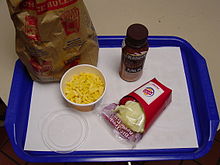| This article needs additional citations for verification. Please help improve this article by adding citations to reliable sources. Unsourced material may be challenged and removed. Find sources: "Diet food" – news · newspapers · books · scholar · JSTOR (May 2008) (Learn how and when to remove this message) |


Diet food (or dietetic food) refers to any food or beverage whose recipe is altered to reduce fat, carbohydrates, and/or sugar in order to make it part of a weight loss program or diet. Such foods are usually intended to assist in weight loss or a change in body type, although bodybuilding supplements are designed to increase weight.
Terminology
In addition to diet other words or phrases are used to identify and describe these foods including light, zero calorie, low calorie, low fat, no fat and sugar free. In some areas use of these terms may be regulated by law. For example, in the U.S. a product labeled as "low fat" must not contain more than 3 grams of fat per serving; and to be labeled "fat free" it must contain less than 0.5 grams of fat per serving.
Process
The process of making a diet version of a food usually requires finding an adequate low-food-energy substitute for some high-food-energy ingredient. This can be as simple as replacing some or all of the food's sugar with a sugar substitute as is common with diet soft drinks such as Coca-Cola (for example Diet Coke). In some snacks, the food may be baked instead of fried thus reducing the food energy. In other cases, low-fat ingredients may be used as replacements.
In whole grain foods, the high fiber content effectively displaces some of the starch component of the flour. Since certain kinds of fibers have no food energy, this results in a moderate energy reduction. Another process relies on the intentional addition of other reduced-food-energy ingredients, such as resistant starch or dietary fiber, to replace part of the flour and achieve a more significant energy reduction.
Example of low-fat foods
See also: Diet drinkThe low-fat foods are those that have 30% of their calories or less from fats. So, if a food contains fewer than 3 gram of fat per 100 calories, it is a low fat food. Examples of cereals, grain, and pasta products are corn or whole wheat tortillas, oatmeal, baked crackers, whole grain versions of noodles, and pita bread. Examples of protein sources are beans, lentils, tofu, egg white, tuna, and peas. On the other hand, polyunsaturated fatty acids such as omega 3 and omega 6 fatty acids can be beneficial to the body. Nutritious foods are avocado, almond, salmon, cashews, seeds, and walnuts.
Controversy
In diet foods which replace the sugar with lower-food-energy substitutes, there is some controversy based around the possibility that the sugar substitutes used to replace sugar are themselves harmful. Artificial sweeteners have been the subject of intense scrutiny for decades, but according to the National Cancer Institute and other health agencies, there is no sound scientific evidence that any of the artificial sweeteners approved for use in the U.S. cause cancer or other serious health problems. Numerous research studies confirm that artificial sweeteners are generally safe in limited quantities, even for pregnant women.
In many low-fat and fat-free foods the fat is replaced with sugar, flour, or other full-food-energy ingredients, and the reduction in food energy value is small, if any.
See also
References
- Definitions of Nutrient Content Claims, U.S. Food and Drug Administration Archived October 5, 2016, at the Wayback Machine
- "Low-Energy-Dense Foods and Weight Management: Cutting Calories While Controlling Hunger" (PDF). CDC.gov.
- "Low fat foods: List, benefits, and meal plan". Medical News Today. 25 July 2019. Retrieved 2019-11-25.
- Diet and good food, National Health Service
- Sandee LaMotte (18 January 2016). "Can artificial sweeteners cause weight gain?". CNN. Retrieved 2019-11-11.
- "The best and worst sugar substitutes for your health". finance.yahoo.com. 3 July 2019. Retrieved 2019-11-11.
- EDT, Janissa Delzo On 3/16/18 at 4:45 PM (2018-03-16). "Artificial sweeteners like Splenda may make Crohn's Disease gut issues worse, a study showed". Newsweek. Retrieved 2019-11-11.
{{cite web}}: CS1 maint: numeric names: authors list (link) - "Artificial sweeteners and other sugar substitutes". mayoclinic.org. Retrieved 2012-10-09.
- Fat-Free vs. Regular Calorie Comparison, U.S. Food and Drug Administration
| Human nutrition and healthy diets | |||||||||||||||||||||||||
|---|---|---|---|---|---|---|---|---|---|---|---|---|---|---|---|---|---|---|---|---|---|---|---|---|---|
| Dieting |
| ||||||||||||||||||||||||
| Nutrition |
| ||||||||||||||||||||||||
| Nutritional advice | |||||||||||||||||||||||||